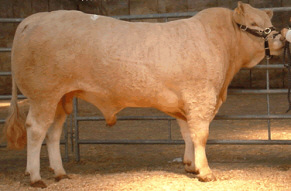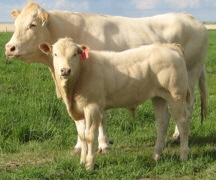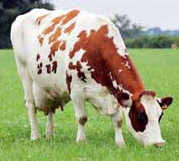



Blonde d'Aquitaine
History
The breed originates from the the Aquitaine district in south west of France embracing the area of the Garonne valley and the Pyrenees.Three strains of cattle comprise the Blonde d'Aquitaine. The are the Garonnais strain, the Quercy, and the Blonde des Pyrenees. The Blonde d'Aquitaine trace to cattle that were in the area in the middle ages, when blonde cattle were used to pull carts carrying weapons and goods. The cattle were valued as draft oxen and for their meat and milk.
The Blonde d'Aquitaine breed exhibits a history of selective breeding pressures that have resulted in the economically valuable breed that we know today. Its muscle development, hardiness and docility are products of its early development as a draft animal.
Blondes today are one of the best and most popular beef breeds in France because of their lean muscling, high growth rate, docility and calving ease due to a high tail setting, large pelvic area and light bone. Numbers in France are growing at about 5% per year. They are the third largest breed in France (with over 480,000 cows) and are quickly catching the Limousin and Charolais breeds. An extensive progeny testing program has ensured continual improvement in the breed, which is reflected in its popularity.
Characteristics
 Photo courtesy of Doncombe Blondes, www.doncombeblondes.netfirms.com |
The head of the Blonde d'Aquitaine is long from poll to muzzle. The forehead and muzzle are broad, the face triangular. Horns are light in colour and thick at the base, darkening at the tip. Blonde d'Aquitaine cattle can be horned or polled, polled fullbloods have been bred in Canada and have been exported to the USA and Sweden.
Mature Fullblood Blonde bulls typically weigh 1600-2600 pounds with some reaching 3000 pounds. Mature Fullblood cows normally weigh 1400-1800 pounds, 1500 pounds being the average and yearling heifers weigh around 1000 pounds.
Blondes are extremely adaptable and are hardy foragers. In addition to the breed’s basic hardiness, its light colour, short hair, active sweat glands and localised muscle control over skin movement (similar to Brahman cattle and horses) give Blondes an added advantage in those kinds of environments.
Statistics
Easy calving - They are fertile, easy calvers and produce very growthy calves. A number of calf characteristics contribute to easier passage thru the birth canal: (1) the calf’s birth weight is spread over a much longer body, (2) a finer bone structure, (3) light muscling at birth, (4) smooth shoulders, and (5) a small triangular head. Cow characteristics, such as width of the pelvis and an inherited hooks-to-pins slope of the rump, also contribute to calving ease. Tests have shown up to 98% unassisted calving from Fullblood Blonde cows. There are many breeders using Blonde bulls on crossbred cows who find that they have far fewer calving problems than with any breed previously tried.Rapid growth - Hybrid Vigour and Blonde genetics combine to give exceptional growth under many conditions.
Quiet temperament - Blondes are typically docile and easy to work.
 Photo courtesy of West Wind Blondes, www.telusplanet.net/public/westwind/females.html |
Extra weight at weaning - Adjusted 205 day weaning weights range from 500 pounds to 700 pounds depending on sex, feed and management. Weaning weights of 600 pounds are typical, without creep feed, for areas with plentiful and rich grass.
High yield carcasses - Efficient production of lean red meat is their primary advantage. Feedlot and carcass tests consistently show superior feed efficiency and a low fat to lean ratio for Blondes and Blonde crosses. Blonde meat marbles, is tender and tasty but does not carry excess external fat. It is unusual for a Blonde to have more than 0.2-0.3 inch of external fat. The breed’s remarkable length and highly developed hind quarter and loin produce a higher percentage of the more valuable steak and roast cuts.
Feed efficiency - Blondes are unsurpassed in feed efficiency. In feed lot tests they consistently convert feed at the rate of 5.3-6.5 pounds of feed per pound of gain. Typical feed lot performance for other breeds is more like 7.5-8.5 pounds feed/pounds gain. Blondes are hardy foragers and readily convert low grade forage to efficient gains. It is not unusual for Blonde calves to gain 3 pounds per day on milk and good grass.
Muscle growth requires much less energy (feed) input pounds/pound than does bone or fat. Thus, Blonde characteristics such as a finer bone structure and minimum external fat, along with well developed muscles, are ideal for feed efficiency. Of course, the basic hardiness of Blondes is also essential to their efficiency.
Comparative
CalvingBlondes consistently prove their ease of calving, with five out of seven trials reviewed rating them easier than Charolais, and four out of seven placing them better than - or equal to - Limousins.
Irish trial work has shown calf mortality within 24 hours of birth to be lower with Blondes (2%) than with the Limousin (3.1%) or Charolais (2.9%). Work done in Yugoslavia with Simmental suckler cows showed the Blonde produced far fewer assisted births (5.6%) than Charolais (16.2%), Simmental (11.1%) and Hereford (12.2%).
Other studies show the breed to have an advantage over other beef breeds when mated with Friesian cows, with one trial finding that only 6.1% of calvings requiring assistance, compared with 17% for Charolais, 11.9% for Limousin and 17.8% for Belgian Blue.
Meat
Evidence from the MLC shows that the Blonde's superior killing out means its carcase growth rates compare favourably with any other major breed.
While it's daily live weight gain may be lower than the Simmental or Charolais, the small amount it loses in total growth is more than recouped through its ability to produce quality carcases. Major trials in several countries have underlined these findings.
In a New Zealand trial of 120 beef breeds on Aberdeen Angus cows, Blonde sired crossbreds outperformed all others, achieving 68.3% lean meat (other breeds 67.1 - 62.4%), with an advantage of 16.4% carcase weight and 22.4% saleable meat over the pure Angus control group.
Continental work has shown the Blonde to have superior feed conversion efficiency to main competitor breeds. German work rated Blonde bulls ahead of Simmental, Limousin and Peidmontese x German Brown bulls.
Many studies from all over the world confirm the Blonde's outstanding conformation and ability to produce carcases that contain more meat, extra meat in the higher priced cuts, lower bone content and lower dressing out than competitor breeds when crossed with a wide variety of damtypes.
MLC work identifies advantages like the breed's lower backfat levels, which - at 2.4 mm - are similar to Limousin, but below those of other major breeds (Simmental 3.6 mm; Charolais 3.3 mm; Hereford 3.8 mm).
Data from 25 years of testing at the Egtved beef testing station in Denmark showed that Blondes achieved better eye muscle area than other breeds from smaller carcases, which means much more meat and less waste for abattoirs and butchers.
In their trial's carcases from 13 month old Blondes averaged 92.8 square centimetres eye muscle area from a live weight of 576 kgs, a significant advantage over it's nearest rival, the Charolais (87.4 sq cm, 627 kgs) and the other breeds tested (Limousin 86.1 sq cm, 557 kgs; Simmental 80.6 sq cm, 650 kgs; Hereford 71.2 sq cm, 587 kgs).
This is supported by Yugoslavian trials which show that, when crossed with Simmental x Holstein heifers, Blondes sires produced eye muscles averaging 100.9 sq cms (Limousin 95.9; Charolais 91.6; Simmental 84.0). On pure Simmental, Blondes produced a 102 sq cm eye muscle (Charolais 94.6; Limousin 94.4; Simmental 89.2). Both male and female Blonde-sired animals maintained their advantage when the carcasses were dressed out.
Distribution
The Blonde d'Aquitaine can be found all around the world and is particularly popular in Europe, America, Canada and Australia.References (the above information was cited from the following sites)
www.ansi.okstate.edu
www.blondecattle.org
www.blondes.asn.au
www.doncombeblondes.netfirms.com
www.telusplanet.net/public/westwind/females.html


